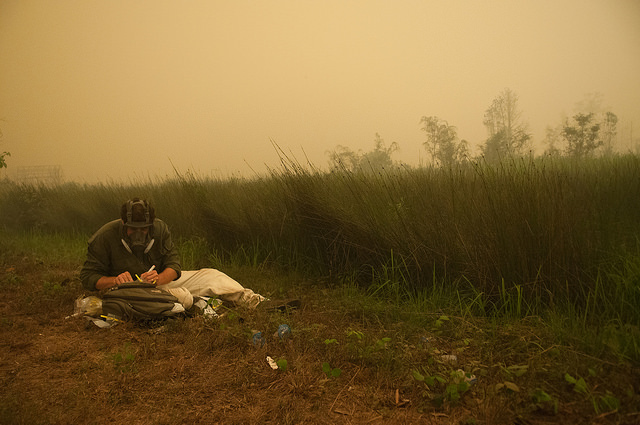
When fires tore through peatlands in Sumatra, Indonesia, in June 2013, the immediate effects were devastatingly familiar. In just one week, up to ten per cent of Indonesia’s average annual emissions of greenhouse gases flooded the atmosphere.
Rare animals and plants were put at risk, as well as human health, as hundreds of thousands of people suffered in the highly toxic air. Smoke also poured into neighbouring Singapore, causing the highest pollution levels in the country’s history.
However, one element in the crisis puzzled scientists.
“Everyone had been focusing on the idea that large fires occurred in Indonesia during major droughts during El Niño years,” says Katia Fernandes, a research scientist from Columbia University.
“But that dry season was not particularly dry. It got us asking: What are the other drivers of these fires?”
Fires in Indonesia usually begin when forested land is set alight to clear space for agricultural use, such as palm oil plantations. The blazes typically occur during the dry season, which stretches from July to October. Although they are started by humans, El Niño-driven droughts have long been known to exacerbate the risk of fires spreading, as they further dry out highly-flammable peatlands, creating a tinderbox.
TURNING UP THE HEAT
Katia and a group of scientists from the Center for International Forestry Research (CIFOR), the International Center for Tropical Agriculture (CIAT) and Temple University set out to analyze if another factor, besides seasonal droughts, played a significant role in sparking fires.
To do this, they focused on the role that temperature plays in affecting fire risk in a tropical climate, using Indonesia as their case study.
The study uses a statistical model that builds upon more than 20 years of data from meteorological stations and remotely-gathered observations on fires.
Concentrated on the blaze-prone areas of Sumatra and Kalimantan in Borneo, it reveals that if the Indonesian dry season is unusually dry, temperature does not play a significant role in sparking fires. However, when the dry season is wet or average and temperatures are unusually high, the risk of fires soars.
DAMPENING FLAMES
“It’s not intuitive – fires breaking out when everything is wet,” says Christopher Martius, the CIFOR Team Leader for Climate Change research who is a co-author of the study. “But sometimes you have to look beyond what is obvious.”
The study explains that as temperatures rise in a wet climate during dry season in Indonesia, more and more of the water on Earth evaporates into vapour and enters the atmosphere. This accelerated process dries out soil and vegetation, leaving it more vulnerable to fires.
Climate change is also a critical factor. The data modelling shows that if it were not for the cumulative effect of the rising trend in temperatures in recent years, warm temperatures during an average to wet dry season would not be as likely to tip the balance in favour of fires.

Figure above: JASO time series of Kalimantan and Sumatra domain anomalies. Standardized burned area (StdBA), standardized precipitation (StdPr) and temperature anomalies (TempAn) in degrees Celsius. Baseline period for climatologies: 1995–2015.
FEARS FOR THE FUTURE
The research includes projections for the coming decades. Although rainfall is not expected to change in the near future, temperatures will continue to rise. That means a greater probability of fires in years when Indonesia is not experiencing drought. It also suggests that the country may have to bid farewell to the relief of wet, cool seasons when fire risk is currently low.
More fires, more often, would have a huge knock-on effect for people and the planet. When degraded peatlands burn, large amounts of carbon dioxide – the biggest driver of climate change today – are released into the atmosphere.
Fires in Indonesia in September and October of 2015 released 11.3 million tons of carbon per day, higher than the daily emissions of the entire European Union. The smoke generated by fires not only threatens public health, but also harms flora and fauna, including endangered species like the orangutan.
FIRE PREVENTION
“The evidence from our research is incredibly important for disaster risk reduction to stop fires in their tracks,” says Martius.
It is generally thought that the greatest threat of fires occurs during drought years. Even short dry spells in non-drought years, such as those identified as being behind the 2013 Sumatra fires, are also a risk. However, fire management agencies now have another factor to consider.
“People need to understand that with hot temperatures, even if the dry season is wet or average, they still have to be prepared for blazes,” says Martius.
The team behind the research hopes their findings will not only lead to immediate action in Indonesia, but also in other high-risk countries with tropical climates.
“We don’t want to give a negative message,” says Fernandes. “We simply want to provide information that assists planning.”
“Armed with this evidence, people should be better prepared to deal with fires in situations in which they never thought could happen.”
*This research was carried out by CIFOR, Columbia University, CIAT and Temple University.
We want you to share Forests News content, which is licensed under Creative Commons Attribution-NonCommercial-ShareAlike 4.0 International (CC BY-NC-SA 4.0). This means you are free to redistribute our material for non-commercial purposes. All we ask is that you give Forests News appropriate credit and link to the original Forests News content, indicate if changes were made, and distribute your contributions under the same Creative Commons license. You must notify Forests News if you repost, reprint or reuse our materials by contacting forestsnews@cifor-icraf.org.
